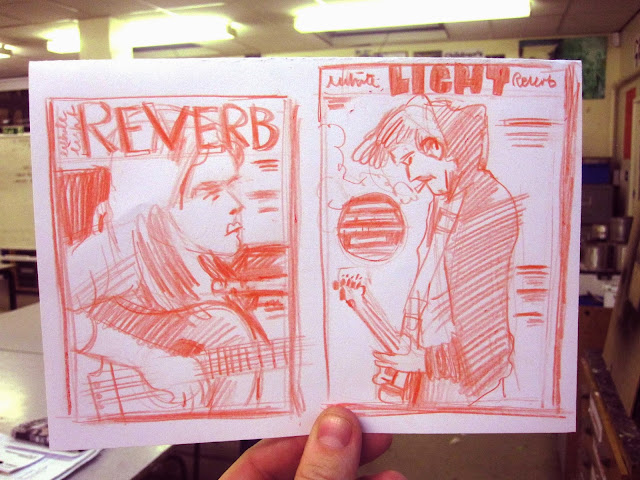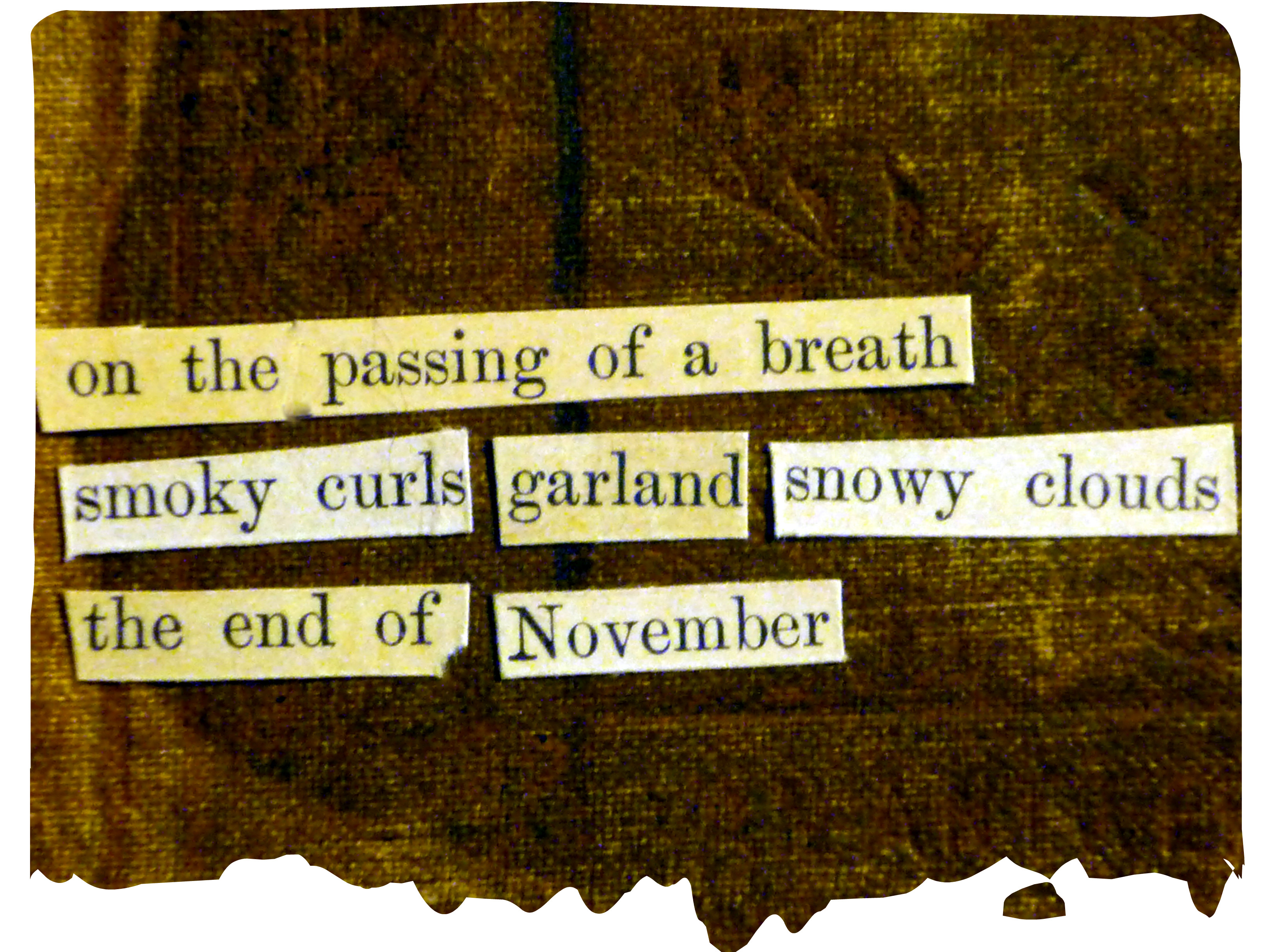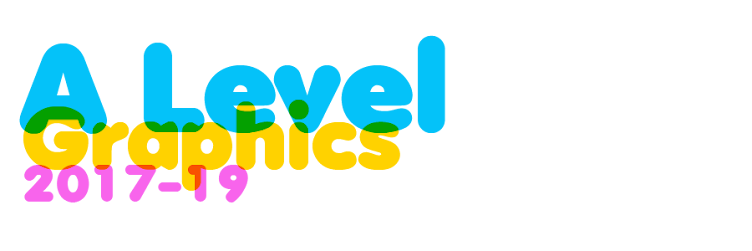Wednesday 13 December 2017
Monday 4 December 2017
Intro Contextual Investigation for Gig Posters
Task:
Over a few pages in your sketchbook, complete a contextual investigation into gig posters as a 'form'.
Use THIS helpsheet to help you structure your findings and responses.
Here are a few ways that you could begin your investigation:
- Print off a range of posters, either new or old or a mix of both - scamp some of them and discuss why they are characteristic of the form.
- Complete a short 'history of' gig posters
- ...
Remeber that your pages should always have lots of 'your hand' in them. This means including your personal touch that is in keeping with the project, drawing, decorating, annotating etc.
We should open your sketchbook to pages full to brimming with examples of the artefacts, and your responses in written and visual terms. If you don't like writing, respond in like with drawings/photographs. Have fun with it. How you present is vitally important - it communicates your creativity before your words do.
Deadline
Thursday 14th of Dec.
There is a film on the Student Shared called 'Just Like Being There' that is about the current state of Screenprinted gig posters. Feel free to watch and incorporate elements into your presentation.
Wednesday 22 November 2017
Drafting and Photoshoot


Objective
To prepare resources for your magazine cover
To further the design process towards your magazine cover
Tasks
Tasks
1. Over a few pages, draft examples of your magazine.
See my examples above but do at least four—two per sketchbook page
To get ideas for my drafting I have typed 'musician' into Pinterest and used the results as a springboard. Do the same. These should be 'tighter' than the scamps.
Using pencil crayon to draft and then 'tightening up' using pen is a good habit.
Remember to annotate your work with thoughts as you progress.
Using pencil crayon to draft and then 'tightening up' using pen is a good habit.
Remember to annotate your work with thoughts as you progress.
2. Complete a photoshoot of images for the cover or equivalent illustration artwork. Present in a relevant manner.
How does relate to the assessment objectives? See HERE
AO2 1 3 4 5
AO3 2 3 4 5
AO4 1
Checklist for assessment
Inventive drafting, lots of relevant and well-lit images
Time needed?
3 hrs
Deadline
Wednesday 29th of Nov
AO2 1 3 4 5
AO3 2 3 4 5
AO4 1
Checklist for assessment
Inventive drafting, lots of relevant and well-lit images
Time needed?
3 hrs
Deadline
Wednesday 29th of Nov
FAQ.
Sir, can you suggest some basic resources for taking photos of my subject in natural light?
Sir, can you suggest some basic resources for taking photos of my subject in natural light?
Below is a link to a blog post that deals with this very issue!
Monday 20 November 2017
Create an Magazine cover with InDesign

Objective
In order for you to fully grasp the potential of InDesign and the complexity/simplicity of page layout, you are to complete a very straight-forward task.
Task
Using InDesign, copy a magazine cover and double page spread as closely as you possibly can.
That means taking a photo that emulates the one on the original cover - to do this successfully you must consider the following: choice of models, clothes, make up, lighting, pose and location (as relevant).
Then you'll have to hunt for typefaces that are as close to the originals. Use FontDoc and Dafont.
If the cover includes handmade graphics then you'll have to draw them, scan them and use your recent Photoshop skills to get them into place.
Presentation
Annotated screenshots of progress
Final design.
Checklist for assessment
Within this task I would like you to evidence basic InDesign tasks, taking clear photography and attempting image editing in Photoshop.
Deadline
tbcIf you have a situation where the cover model is obscuring the masthead, then this tutorial will help you out.
Then get this InDesign Magazine Cover Tutorial paused and ready before you start.
Monday 13 November 2017
Cornell Method note-taking.
Many students are struggling to take notes that are thorough and can be recalled later. From now on, take notes using the 'Cornell Method'. If you are not familiar with this method of note-taking, watch the clip below. It will also help you with your other courses.
Tuesday 7 November 2017
Mag Cover Photo
Objective
To work towards the copy of a magazine cover.
Pre Task
Choose a magazine that has some interesting design elements, that you actually like and look closely at the image. You are to (eventually) recreate the cover.
Actual Task
Take a set of at least 15 photographs as close to the original as you can get.
Actual Task
Take a set of at least 15 photographs as close to the original as you can get.
In order for you to get a decent result you must take the image yourself. Although we can touch up and edit images in Photoshop, there is a limit to what the program can salvage from a bad image. Therefore your image must be as good as it can be.
Important!! Consider the light, wardrobe, pose, setting, background.
Important!! Consider the light, wardrobe, pose, setting, background.
Presentation
Contact sheet in your sketchbook or similar, creative way of presentation.
Description of how you attempted to get the shot - lighting wardrobe, direction, expression pose, setting.
Description of how you attempted to get the shot - lighting wardrobe, direction, expression pose, setting.
Checklist for assessment
Plenty of trial and error when it comes to getting the correct pose.
Deadline
15th Nov.Wednesday 1 November 2017
Masthead research, experimentation and design
Objective:
To create a masthead for a magazine of your own devising.
To understand the variety of different methods for using typography
To experiment and play with typography.
Task:
Using a few names for your magazine, create a series of experimentations and explorations.
Use the presentation above to inspire your ideas.
Utilise different processes such as Photoshop, Illustrator, paint, ink, photocopy, pencil, etc etc.
Experimentation is key! Be creative :)
Graphic Communication Group Chat - WhatsApp

We are trialling the use of WhatsApp with our Sixth Form groups. The underlying purpose of WhatsApp is to facilitate communication, and at its most basic level, education is nothing but communication. WhatsApp can provide a channel through which we can achieve faster and more seamless communication with students. It can also increase the level of communication between students and create another venue for learning, help and feedback.
Please note that this WhatsApp group is for educational use only and normal class rules apply!
Use this link below to join the group.
https://chat.whatsapp.com/6JgNT19lv3z13gpy3hT44I
If the link doesn't work, add your name and email to this list and I will send you a link:
https://docs.google.com/document/d/1p5yV5VdQReF9Q-T_YDb8M6I1bvgP5buobumno8kKAy4/edit?usp=sharing
https://chat.whatsapp.com/6JgNT19lv3z13gpy3hT44I
If the link doesn't work, add your name and email to this list and I will send you a link:
https://docs.google.com/document/d/1p5yV5VdQReF9Q-T_YDb8M6I1bvgP5buobumno8kKAy4/edit?usp=sharing
We potentially intend to use Whatsapp for some of the following Education Strategies:
- Use the Group Chats feature to create learning and study groups
- Create audio lessons that can be sent directly to students.
- Stay in contact with students outside the classroom
- Send videos to students.
- Send graphics such as pictures or charts directly to students
Tuesday 31 October 2017
Magazine Scamps, Research and Analysis.

Objective
To source and collect similar artefacts that will act as models and stimulus for your design.
To learn about the conventions of magazine covers and the differences between mainstream and niche design.
Tasks
You are going to produce a few pages of research before you begin designing your own.
1 Collecting
Using the web (Pinterest, google search etc), reference books and actual printed examples, collect together examples of magazine covers and double page spreads (DPSs) that interest you in terms of design.
Use screen grabs from Pinterest... but not just Pinterest!
Tip: go into a town library or CO-OP and photograph the cover and DPSs. Failing that, try WHSmiths in Shrewsbury.
*Print them off in various sizes in readiness for your sketchbook.*
2 Scamps and Annotation
As part of your magazine research presentation, scamp some of the examples that you find. Feel free to use colour. Use the 'Magazine Covers Checklist' HERE to annotate some of the elements of magazine design.
3 Analysis
You might have found that magazines (and indeed other graphic products) fall along a sliding scale from mainstream to niche. The designs reflect this is some way. Often, mainstream design is conventional and straightforward whereas niche products rely on surprising design elements.
Ensure that you include your own personal response. There is a really simple helpsheet called 'Ways Of Looking' HERE
Finally, use your burgeoning analysis skills to discuss:
Contrast, Repetition, Alignment and Repetition. Analysis help is HERE
Deadline
Monday.
Monday.
Monday 30 October 2017
Year 12 Graphic Comm - Sketchbook so far...
All pages must have some form of personal annotation on them. Please DO NOT just describe process. If you are stuck, refer to the annotation sheet in your sketchbook.
Deadline Monday.
The pages that should be present in your book include:
- Poem
- Elements fo CKent -paint marks, manipulated text, text in shape, experiments with type, etching or photographs etc
- Books Without Words - Notes
- CKent - research case study
- Why I Love Comics - Notes
- Final CKent design
- We Don't Serve Yur Type - Notes
- Magazine name brainstorm
- Magazine research
Brainstorming list - ideas for a magazine name.
 Pic 1
Pic 1
Pic 2
Objective
To begin forming ideas for your magazine.
Task
In your sketchbook, create a page of lists that evidence how you have arrived at the name of your magazine.
Start by using list titles like: Terms Types Tools Classics Adjective Existing (see Pic 1)
Start by using list titles like: Terms Types Tools Classics Adjective Existing (see Pic 1)
Fill these lists by either using your knowledge of the subject or utilising the web to look on glossaries and terminology lists.
Then put the collected words into a thesaurus and see what you get.
Then put the collected words into a thesaurus and see what you get.
Next, attempt to put these words together in different ways, maybe spell them differently. Fill a page.
This is the creative bit, don't feel restricted—the good ideas come when you let go a bit. (see Pic 2)
Checklist for assessment
Plenty of relevant and irrelevant, creative ideas / clear photo / at least 2 full pages—lay it out the same as I have, but include more / clear written work.
Deadline
Start of Tuesday's lesson.
Plenty of relevant and irrelevant, creative ideas / clear photo / at least 2 full pages—lay it out the same as I have, but include more / clear written work.
Deadline
Start of Tuesday's lesson.
Monday 16 October 2017
Collection - Independent study
The task is on the presentation.
Handin date: Lesson, Monday 30th Of October
Friday 13 October 2017
Aaaaarrgh! What do I annotate and what do I write?
Why do we annotate pages, what do you annotate and what do you write?
Basically, anyhing that the assessor needs to know and understand about your work. Most of this is hidden in your brain, you need to get it out.
The majority of annotation should happen at the time of making, not as an afterthought. You'll be supposed how much it can clarify your thinking and add a little extra unexpected spark to your work.
Therefore, an annotation can take place prior to work beginning (imagining, prioritising, explaining and inventing what you are attempting to do), during (evaluation of current ideas, analysis of work, comparisons) and after (evaluations, concluding, giving opinions).
N.B If it's just a description of events, and has no personal element, it won't be good.
Be creative with your annotations, lift ups, overlays, writing over photos, labels, speech bubbles.
For the Corita Kent work, you can annotate everything that would otherwise be lonely on a page.
This includes:
* The ingredients - scanning and warping type - found photographs and etchings - inked type and type in a shape - splodges - cut out type
* A few work in progress shots from Photoshop
* Finals
I have an annotation sheet that might be helpful. It's HERE.
Monday 9 October 2017
Scamp copies of Magazine Covers - Independent study

Objective
To further understand the part white space plays in a graphic artefact.
To become aware of how designers balance elements on a page.
Info: A 'scamp' is a first rough idea or mockup.
Info: A 'scamp' is a first rough idea or mockup.
Tasks
1 Draw
Gather a range of front pages from different types of magazines. This can be via Pinterest or your own examples.
1 Draw
Gather a range of front pages from different types of magazines. This can be via Pinterest or your own examples.
In your sketchbook, draw 2 pages of front pages. Feel free to work in slightly different sizes.
Look at your example and quickly and loosely sketch the page. Pay close attention to the light and dark tones—allow your brain to 'threshold' the greys into either light or dark tones. See my measly example above.
2 Annotate
Using the magazine checklist HERE, annotate some of your drawings and ensure that you have included all of the elements.
Feel free to go further and annotate further...
2 Annotate
Using the magazine checklist HERE, annotate some of your drawings and ensure that you have included all of the elements.
Feel free to go further and annotate further...
Checklist for assessment
2 pages of front pages - at least 15.
Time needed
Three hours.
Deadline
Wednesday the 18th of October.
2 pages of front pages - at least 15.
Time needed
Three hours.
Deadline
Wednesday the 18th of October.
Wednesday 4 October 2017
Sister Corita Kent Case Study - Independent Study

Objectives
To further your understanding of graphic communication practitioners
Task
Using the web, research and present a case study about Sister Corita Kent.
The contents of the case study could include the following.
To further your understanding of graphic communication practitioners
Task
Using the web, research and present a case study about Sister Corita Kent.
The contents of the case study could include the following.
Research the 'Sister Corita Kent' and present your findings in your sketchbook.
Look further than Wikipedia.
Look further than Wikipedia.
Your creative findings should include:
Checklist for assessment
Relevant images, in-depth research your own words (no copy and paste), accurate emulation.
- a comprehension response (explain)Describe who the artist is. Please do NOT include a biography.Explain your response. Use the pink section on the WAYS OF LOOKING sheet to help your questioning.an analytical response (compare and contrast)Criticise and analyse their work. Use the WAYS OF LOOKING sheet to help your questioning.Take a number of typical examples and bullet point why they are characteristic of their work and wider movementa creative response (use your imagination)Copy their style, emulate it. (Don’t copy individual images, translate it..)Where would you find this style working best? In what other ways could it be used?a research response (dig deeper)Find other artists that are similar or linked? Then, consider the context - what other designers are working at the same time?Include a range of relevant work.Research to find out who the designer has been influenced by or has influenced. To do this you may need to read an interview with the artistand where did they work?
Checklist for assessment
Relevant images, in-depth research your own words (no copy and paste), accurate emulation.
Time needed
4 hours
Deadline
Wednesday
Monday 2 October 2017
Corita Kent Cut & Paste Poetry
Objective
Look at and emulate the work of Sister Corita Kent.
To utilise differing methods of generating content and design.
Info
The Surrealists used numerous techniques and games to provide inspiration. Many of these are said to free imagination by producing a creative process free of conscious control. The importance of the unconscious as a source of inspiration is central to the nature of surrealism.
Task
You are going to allow this uncertainty to influence and inspire your work... both visually and written. Read through the instructions in the presentation above.
Template HERE
Presentation
Images of sketchbook pages, screenshots of work-in-progress, photographs of final book.
Checklist for assessment
Does it look like a creative nun made it? Does your poem make people weep, sigh or smile? Both should be yes.
Deadline
TBCWednesday 27 September 2017
Independent Study Task - Cut Up Technique

Task
Research the 'Cut Up Technique' and present your findings in your sketchbook.
Look further than Wikipedia.
Your findings should include:
- a comprehension response (explain) - describe what it is, what is it for and identify key players, show examples
- an analytical response (compare and contrast) - criticise the technique and judge where you think it could be used to its full potential
- a creative response (use your imagination) - how would you develop this idea? In what other ways could it be used? How can it be explored?
- a research response (dig deeper) Have you found other methods that are similar or linked?
Deadline: start of lesson Wed 4th of October.
Tuesday 26 September 2017
Reading and note-taking task 1
(Above are two ways of taking notes from a short chapter. The top one takes longer but is much more helpful when attempting to remember and recall information.)
Objective
Objective
To give you an overview of the history of - and recent developments of - graphic communication in order to inform your written analysis work.
Task
Read Books Without Words
N.B. Don't be put off, use a dictionary and the web for help. You are entering the world of grown-up reading with big words and concepts — if you don't work at it, you won't get it. Use a dictionary.
Take notes and make drawings in your sketchbook.Get firmly into the habit of drawing whilst you are note taking. Explain visually as well as with writing.
Take notes and make drawings in your sketchbook.Get firmly into the habit of drawing whilst you are note taking. Explain visually as well as with writing.
Collect 3 questions about the text for me or the group to answer.
Presentation
Presentation of your work is very important. Your pages should be things of beauty.
Checklist for assessment
Detailed notes
Deadline
Tuesday.
Monday 18 September 2017
Friday 15 September 2017
Covering your sketchbook.

Objective
As you are a Graphic Communication, you will need to communicate your magic powers to the general public! To do this you will create a beautiful sketchbook cover from stuff you have collected.
Task
Create a Pinboard that is full of stuff you could cover your sketchbook with. Consider stickers, photos, artwork, illustrations, patterns, textures, maps, stamps, labels etc etc.
We will be pasting them into Photoshop and resizing them, so there is no need to print anything off just yet.
Thursday 14 September 2017
Subscribe to:
Posts (Atom)








